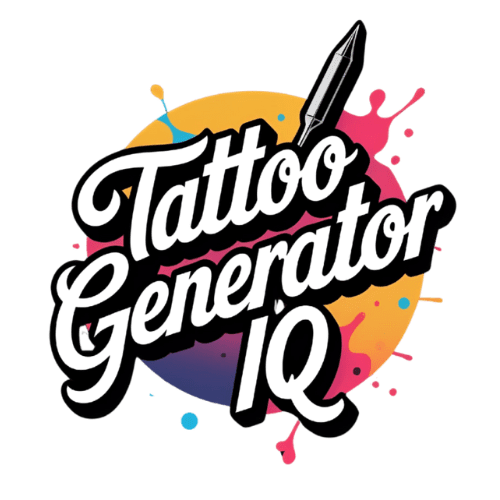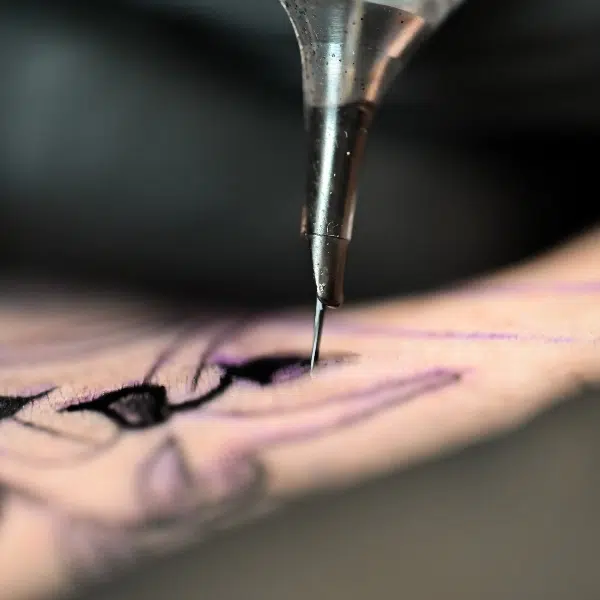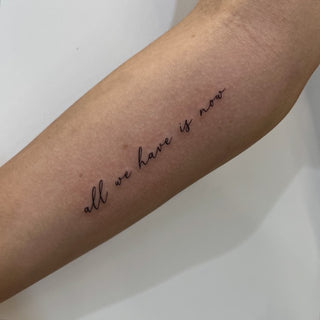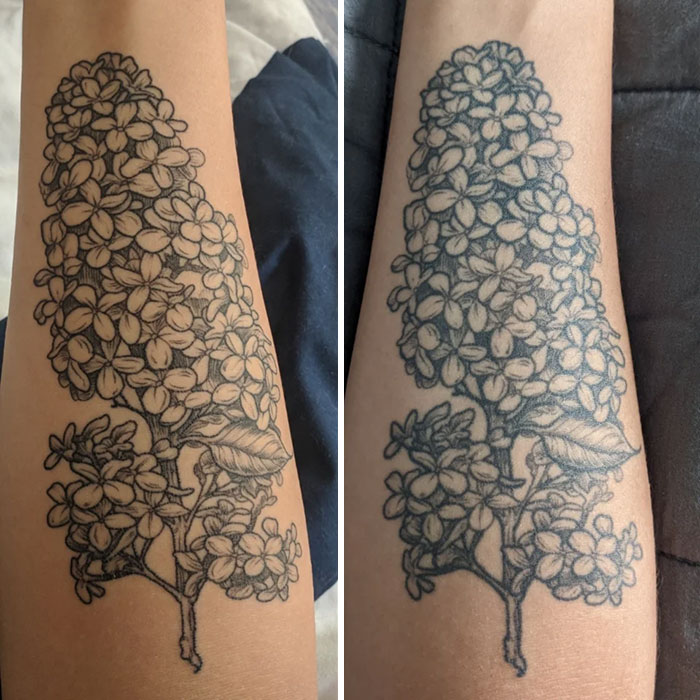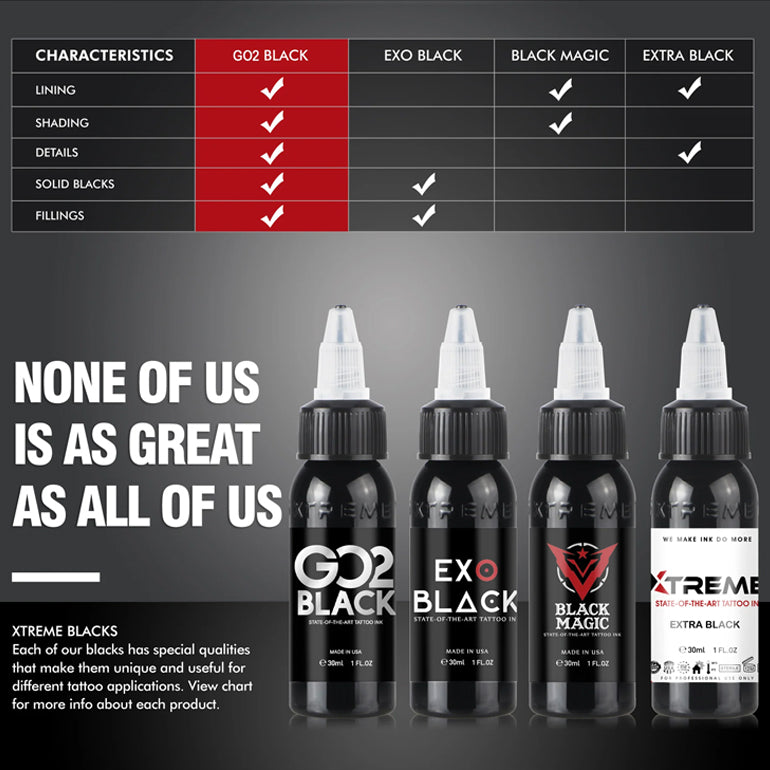25 Aged Fine Line Tattoos That Actually Look Better With Time (Real Examples Inside)
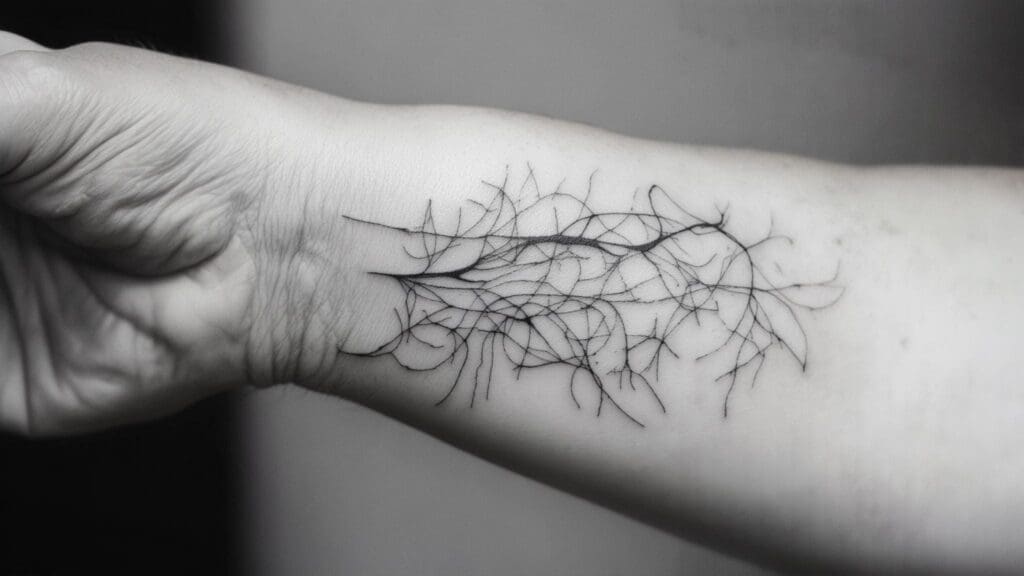
TikTok users are sharing their aged fine line tattoos with mixed reactions – some showing beautiful evolution while others reveal disappointing fading. According to Allure’s investigation into fine line tattoo longevity, the debate centers around proper execution and realistic expectations. I remember scrolling through these viral videos last summer, watching people reveal their 2-year-old delicate designs that had either maintained stunning clarity or blurred beyond recognition. The stark difference made me realize how crucial it is to understand which fine line designs actually improve with age.
You’re about to discover 25 aged fine line tattoo designs that defy the fading stereotype. These aren’t just pretty pictures – they’re battle-tested designs that maintain their beauty and meaning years after the initial session.
Table of Contents
- Understanding Fine Line Tattoo Aging
- Critical Factors That Determine Longevity
- 1. Single Line Triangle
- 2. Concentric Circles
- 3. Linear Mountain Range
- 4. Geometric Arrow
- 5. Minimalist Hexagon Pattern
- 6. Single Stem Rose
- 7. Eucalyptus Branch
- 8. Minimalist Tree Silhouette
- 9. Delicate Fern Frond
- 10. Simple Lavender Sprig
- 11. Continuous Line Leaf
- 12. Minimalist Succulent
- 13. Wheat Stalk Bundle
- 14. Crescent Moon with Stars
- 15. Constellation Map
- 16. Minimalist Sun Design
- 17. Planet Alignment
- 18. Shooting Star Trail
- 19. Simple Galaxy Spiral
- 20. Infinity Symbol with Flourish
- 21. Minimalist Compass
- 22. Abstract Wave Pattern
- 23. Minimalist Heart Outline
- 24. Single Word Script
- 25. Roman Numeral Date
- How These Designs Perform Over Time
- Artist Skill and Technique Requirements
- Maintenance and Touch-up Strategies
- Advanced Aging Considerations
- Technology and Innovation Impact
- Emerging Preservation Techniques
- Future-Proofing Your Fine Line Tattoo
TL;DR
- Fine line tattoos age differently based on line weight, placement, and design complexity – some actually improve with time
- Geometric designs and simple symbols maintain recognition longest due to predictable aging patterns
- Botanical elements benefit from natural imperfection as lines soften and spread over years
- Placement on stable skin areas (upper back, shoulder blades) extends longevity significantly
- Proper line spacing prevents design elements from merging as tattoos naturally evolve
- Artist skill in needle depth and ink saturation directly impacts 10+ year appearance
- Touch-ups every 5-15 years maintain crisp definition depending on design complexity
Understanding Fine Line Tattoo Aging
Fine line tattoo aging happens in predictable ways once you understand the science behind it. These delicate designs use needle configurations between 3RL to 5RL, creating lines as thin as 0.25mm that naturally spread to 0.5-0.75mm over a decade due to skin cell turnover and collagen breakdown. The aging process isn’t inherently negative – it’s predictable and manageable when you understand the underlying factors that influence how do fine line tattoos age over time.
Source: hyperskintattoo.com
Line thickness directly correlates with longevity in ways that might surprise you. Designs using lines thicker than 1mm maintain definition better after 10+ years compared to ultra-fine 0.25mm lines that may blur significantly. Your skin doesn’t discriminate – it treats all ink as foreign material that needs processing.
Skin cell regeneration cycles every 28 days gradually push ink particles around, causing natural line spread that can enhance organic designs while potentially compromising geometric precision. This biological process works constantly beneath the surface, reshaping your tattoo in microscopic ways that accumulate over years.
Understanding proper technique is crucial for longevity, and our comprehensive guide to fine line tattoo ideas explores execution methods that maximize aging potential while maintaining aesthetic appeal.
Critical Factors That Determine Longevity
Line Weight and Ink Saturation Standards
Proper needle depth of 1.5-2mm into the dermis ensures longevity without causing blowouts, while consistent line weight throughout prevents uneven aging. Quality ink saturation during the initial session significantly impacts long-term appearance, with inadequate saturation leading to premature fading and patchy healing that becomes more pronounced over years.
Needle depth precision determines whether ink settles in the optimal dermal layer – too shallow causes rapid fading while too deep creates blowouts that worsen with age. I’ve seen too many aged fine line tattoo examples where poor initial execution created problems that became obvious only after several years.
Ink saturation density affects how well pigment particles resist macrophage breakdown during the body’s natural immune response to foreign materials. Your immune system constantly works to remove tattoo ink, and insufficient initial saturation gives it an easier target.
Placement Strategy for Maximum Longevity
Areas with frequent movement create faster line degradation due to constant skin stretching. Hands, fingers, and joints experience this mechanical stress daily, while sun exposure accelerates fading particularly on forearms and shoulders. Skin thickness varies significantly by body location, with thicker areas preserving fine line definition longer than thin-skinned areas.
Placement considerations extend beyond aging concerns to include pain tolerance, and our detailed tattoo pain scale guide helps you understand how different body areas affect both comfort during application and long-term tattoo preservation.
| Body Location | Skin Thickness | Movement Level | Sun Exposure | Longevity Rating |
|---|---|---|---|---|
| Upper Back | Thick | Low | Low | Excellent (15+ years) |
| Shoulder Blade | Thick | Low | Moderate | Very Good (12-15 years) |
| Forearm | Medium | Medium | High | Good (8-12 years) |
| Wrist | Thin | High | High | Fair (5-8 years) |
| Fingers | Thin | Very High | High | Poor (2-5 years) |
| Thigh | Thick | Low | Low | Excellent (15+ years) |
| Ankle | Thin | High | Moderate | Fair (5-8 years) |
Skin movement patterns create directional stress on tattoo lines in ways you might not expect. Joints and high-mobility areas experience multidirectional stretching that distorts fine details more rapidly than stable placement zones. Every time you bend your wrist or flex your fingers, you’re applying mechanical stress to any tattoo in that area.
UV radiation breaks down ink molecules through photodegradation, with exposed areas requiring SPF 30+ protection to prevent accelerated color loss and line blurring. The sun doesn’t just fade your tattoo – it chemically alters the ink compounds at a molecular level.
Design Complexity and Spacing Requirements
Intricate patterns with closely spaced lines may merge over time as individual lines spread, while simple, well-spaced designs maintain clarity longer than complex artwork. Negative space becomes crucial for preventing designs from becoming muddy as they age, with adequate spacing between elements serving as a buffer against natural line expansion.
Source: tiktok.com
Minimum 2-3mm spacing between design elements prevents line convergence as natural ink migration occurs over 5-10 year periods. This spacing requirement often surprises people who want to maximize detail in small spaces, but it’s essential for long-term clarity.
Detail hierarchy in complex designs ensures primary structural elements use heavier line weights while secondary details can fade without compromising overall recognition. Smart designers build this hierarchy into their work from the beginning, creating fine line tattoo fade resistance through strategic planning.
1. Single Line Triangle
A simple equilateral triangle created with one continuous fine line relies on geometric precision and clean straight lines that age predictably. The mathematical relationships between angles remain recognizable even as the line naturally thickens from 0.25mm to 0.5mm over time, making this design exceptionally aging-resistant.
Geometric shapes distribute aging stress evenly across their structure, preventing vulnerable points that could compromise design integrity over decades. Triangle’s three-point stability creates visual anchors that help the eye reconstruct the intended shape even with moderate line spread or fading.
Aged fine line tattoos in geometric forms consistently outperform other categories because mathematics doesn’t change – a triangle remains recognizable even when the lines aren’t perfectly crisp anymore.
2. Concentric Circles
Three to five nested circles with consistent 2-3mm spacing create a minimalist mandala effect that prevents line convergence as the tattoo ages. The simple geometry maintains recognition even with slight line spread, while the spacing acts as a buffer against natural ink migration that occurs over years of skin cell turnover.
Circular forms age gracefully because curves distribute stress more evenly than angular designs with sharp corners that can become distorted. The flowing nature of circles works with your skin’s natural movement patterns rather than fighting against them.
Consistent spacing ratios between circles maintain proportional relationships even as individual line weights increase through natural aging processes. This mathematical consistency keeps the design balanced and visually appealing for decades.
3. Linear Mountain Range
A continuous line creating a simplified mountain silhouette spans 4-6 inches horizontally, using varying line heights to suggest peaks and valleys without intricate details. The continuous line structure prevents detail loss while the organic mountain form masks minor imperfections that develop as the tattoo ages naturally over time.
Source: reddit.com
Continuous line construction eliminates connection points where breaks or gaps could develop as skin ages and stretches over decades. Fine line tattoos over time benefit enormously from this structural approach because there are no weak points where the design could fail.
Mountain silhouettes benefit from natural imperfection expectations – slight line softening enhances the organic landscape quality rather than detracting from it. Real mountains aren’t perfectly geometric, so aging actually makes these tattoos more realistic.
Sarah, a 34-year-old graphic designer, got a linear mountain range tattoo on her upper back in 2018. Five years later, the design has maintained its crisp silhouette with only minimal line softening that actually enhances the natural mountain appearance. The continuous line structure prevented any breaks or gaps, while the stable placement area protected against movement-related distortion.
4. Geometric Arrow
A streamlined arrow design uses straight lines and precise angles while incorporating negative space for visual impact, typically ranging from 3-5 inches in length. The bold geometry and strategic negative space ensure sharp angles may slightly round over time but maintain overall design integrity and directional symbolism.
Arrow designs rely on directional flow rather than perfect line precision, allowing for graceful aging as angles naturally soften without losing symbolic meaning. The pointing direction remains clear even when individual lines aren’t razor-sharp anymore.
Strategic negative space provides visual breathing room that prevents design elements from merging as natural line spread occurs over 10+ years. This spacing is what separates arrows that age well from those that become unrecognizable blobs.
5. Minimalist Hexagon Pattern
Three interlocking hexagons create a honeycomb-inspired design with clean lines and geometric precision, each hexagon measuring approximately 1 inch in diameter. The interlocking structure maintains overall form even with minor line spread, while adequate sizing prevents detail loss that could compromise pattern recognition over time.
Interlocking geometric patterns create mutual structural support – if one element ages imperfectly, surrounding elements maintain the overall design integrity. This redundancy is crucial for long-term tattoo success.
Hexagonal shapes offer optimal aging characteristics due to their balanced angle distribution and natural occurrence in organic structures. The six-sided symmetry distributes stress evenly, preventing distortion points that plague other geometric forms.
6. Single Stem Rose
A delicate rose with a long stem uses minimal lines to suggest petals and thorns, emphasizing negative space and simple line work over intricate details. Petal details may soften over time, but the overall silhouette remains recognizable due to the strong stem structure that provides visual anchoring as fine details naturally fade.
Source: shutterstock.com
Botanical designs benefit from organic imperfection expectations – as lines soften, they often enhance the natural quality rather than appearing flawed. A healed fine line tattoo of a rose can actually look more realistic after aging than when it was first completed.
Stem structure provides hierarchical design stability where the primary element uses heavier line weight while secondary details can fade without compromising recognition. This hierarchy is essential for botanical tattoos that want to age gracefully.
Botanical elements are among the most popular choices for fine line work, and our extensive collection of flower tattoo ideas showcases how delicate floral designs can maintain their beauty through proper execution and aging considerations.
7. Eucalyptus Branch
A flowing eucalyptus branch with characteristic oval leaves uses fine lines to create natural movement and organic shapes, typically measuring 4-6 inches in length. The organic, flowing lines age gracefully because natural imperfection in botanical elements effectively masks minor line spread that occurs through normal aging processes.
Eucalyptus leaves’ natural variation in size and spacing creates design flexibility that accommodates aging changes without appearing distorted. Real eucalyptus branches have irregular, organic qualities that aging tattoos naturally emulate.
Flowing branch structure distributes aging stress along curved paths rather than concentrating it at sharp angles or connection points. This distribution prevents the catastrophic failure points that can ruin other tattoo styles.
8. Minimalist Tree Silhouette
A simple tree outline focuses on trunk and basic branch structure while avoiding intricate leaf details, with height ranging from 3-5 inches depending on placement. The simplified silhouette maintains recognition even with line spread, while the strong trunk provides visual anchoring as branch details may soften over decades.
Tree silhouettes establish clear visual hierarchy where trunk stability anchors the design even as finer branch details naturally fade or blur. This hierarchy ensures the tattoo remains recognizable even when fine details become less distinct.
Simplified botanical forms avoid detail density that could become muddy with age, maintaining clear recognition through basic structural elements. The key is knowing what details to include and what to leave out from the beginning.
9. Delicate Fern Frond
A single fern frond with minimal detail uses fine lines to suggest characteristic segmented leaves without overwhelming complexity. The repetitive pattern structure helps maintain overall design recognition even if individual segments blur slightly over time, while the organic nature masks aging imperfections effectively.
Repetitive natural patterns create redundancy that preserves design recognition even when individual elements fade or merge slightly. If one segment becomes unclear, the surrounding segments maintain the overall fern pattern.
Fern frond segmentation provides natural break points that prevent catastrophic aging failure across the entire design. Each segment ages independently, so problems in one area don’t compromise the whole tattoo.
10. Simple Lavender Sprig
A minimalist lavender design balances dotwork flowers with clean lines for stem and leaves, creating visual interest while maintaining aging resilience. The dotwork elements may merge slightly over time, but the linear stem provides structural integrity that preserves overall botanical recognition and symbolic meaning.
Dotwork elements age differently than line work – dots tend to expand uniformly while maintaining circular recognition better than complex linear details. This expansion can actually enhance the clustered flower effect of lavender blooms.
Botanical stem structure creates design backbone that maintains recognition even as decorative flower elements naturally soften with age. The stem acts as the visual anchor that holds the entire composition together.
11. Continuous Line Leaf
A single leaf created with one flowing line showcases artistic skill while maintaining ultimate simplicity for aging purposes. The continuous line structure eliminates connection points where breaks could develop, while natural line spread actually enhances the organic leaf quality rather than detracting from the design’s botanical authenticity.
Single continuous lines eliminate weak points where separate line segments might disconnect or fade unevenly over time. This structural integrity is crucial for long-term tattoo success.
Organic leaf shapes benefit from line softening because natural leaves have soft, irregular edges rather than precise geometric boundaries. Aging actually makes these tattoos more botanically accurate.
12. Minimalist Succulent
A geometric interpretation of a succulent plant uses simple shapes and clean lines to suggest layered leaves without excessive detail. The geometric approach to botanical design provides structural predictability that ages consistently while maintaining plant recognition through simplified form rather than realistic detail.
Geometric botanical interpretations combine organic recognition with predictable aging patterns of geometric shapes. You get the best of both worlds – natural symbolism with mathematical stability.
Layered leaf suggestion through simple shapes creates depth without detail density that could become problematic as the tattoo ages. The layering effect remains clear even when individual lines thicken over time.
13. Wheat Stalk Bundle
Three to five wheat stalks bundled together use fine lines for stems and minimal detail for grain heads, typically measuring 4-5 inches in height. The bundled design provides mutual visual support where individual stalks reinforce each other, while agricultural simplicity effectively masks minor detail loss that occurs over time.
Source: pinterest.com
Bundled designs create visual redundancy where multiple similar elements support overall recognition even if individual components fade. Fine line tattoos after 10 years benefit enormously from this redundancy principle.
Agricultural motifs carry cultural familiarity that aids recognition even when fine details become less distinct through natural aging. People instinctively recognize wheat stalks even when the details aren’t perfect.
14. Crescent Moon with Stars
A simple crescent moon accompanied by three to five small stars uses clean lines and strategic placement for visual balance. The bold, simple shapes ensure excellent longevity, with star points potentially rounding slightly over time while celestial recognition remains strong due to archetypal shape familiarity.
Celestial symbols tap into archetypal recognition patterns that transcend perfect line execution – slight imperfections don’t diminish symbolic impact. The moon and stars remain meaningful even when they’re not geometrically perfect.
Crescent moon curves age gracefully because curved lines distribute stress more evenly than angular designs with sharp transition points. The flowing curve works with your skin’s natural movement patterns.
15. Constellation Map
A specific constellation represented by connected dots and fine lines typically features 7-12 stars with connecting lines showing the astronomical pattern. Dot elements maintain definition exceptionally well over time, while connecting lines provide contextual relationships that preserve constellation recognition even with slight line spread.
Dot-based designs age more predictably than complex line work because circular expansion maintains recognizable form better than linear distortion. Dots become slightly larger circles, but they remain clearly identifiable as stars.
Constellation patterns rely on relative positioning rather than precise line quality, making them inherently resistant to aging-related detail loss. The pattern remains recognizable even when individual elements aren’t perfect.
16. Minimalist Sun Design
A simple circle with radiating lines representing sun rays uses consistent line weight and spacing for balanced appearance, typically measuring 2-3 inches in diameter. The central circle provides a strong visual anchor while radiating lines may soften over time but maintain solar recognition through the fundamental sun symbol structure.
Radial designs distribute aging effects across multiple elements, preventing single-point failure that could compromise entire design recognition. If one ray becomes unclear, the others maintain the sun pattern.
Central anchor elements provide stability that maintains design coherence even as peripheral details naturally fade. The circle remains the focal point that holds the entire design together.
17. Planet Alignment
A linear arrangement of simplified planets shows relative sizes using circles and minimal detail to suggest planetary characteristics. The excellent aging potential stems from simple geometric shapes that maintain size relationships clearly even with minor line spread, while linear arrangement provides structural integrity over decades.
Size relationship preservation in planetary designs maintains scientific accuracy and visual impact even as individual planet details may simplify with age. The relative scale remains clear and meaningful.
Linear arrangements create organizational structure that guides eye movement and maintains design coherence through aging changes. The alignment provides a visual framework that holds the composition together.
18. Shooting Star Trail
A single shooting star with trailing lines suggests movement using graduated line weights to create depth and motion effects. The trailing effect actually benefits from slight line spread over time, naturally enhancing the motion blur effect that makes the design more dynamic as it ages.
Source: pinterest.com
Motion-based designs can improve with aging as natural line softening enhances the intended blur or movement effects. Do fine line tattoos age well when they’re designed to benefit from natural changes? Absolutely, when the aging process enhances the intended effect.
Graduated line weights create depth hierarchy that maintains even as individual lines thicken, preserving the illusion of movement and speed. The motion effect becomes more pronounced and realistic over time.
19. Simple Galaxy Spiral
A minimalist representation of a spiral galaxy uses flowing lines and strategic dot placement to suggest cosmic structure without excessive detail. The spiral structure maintains recognition even with line softening, while the cosmic theme naturally accommodates imperfection that mirrors the organic nature of actual galactic formations.
Spiral structures age gracefully because the flowing curves distribute stress evenly and maintain recognizable form even with significant line spread. The spiral pattern remains clear even when individual lines aren’t perfectly defined.
Cosmic themes benefit from natural imperfection expectations – real galaxies have irregular, organic qualities that aging tattoos can naturally emulate. Aging actually makes these designs more astronomically accurate.
20. Infinity Symbol with Flourish
A classic infinity symbol enhanced with a single decorative flourish maintains mathematical precision while adding personal character. The excellent aging potential stems from the strong geometric foundation where the infinity loop structure provides inherent stability, while decorative elements age gracefully without compromising core symbolism.
Mathematical symbols possess inherent structural stability that transcends perfect line execution – the concept remains clear even with aging changes. The infinity symbol is so culturally embedded that minor imperfections don’t affect recognition.
Infinity loops distribute stress evenly across continuous curves, preventing weak points where breaks or distortions typically develop in angular designs. The flowing curve structure works with natural skin movement.
21. Minimalist Compass
A simplified compass design uses basic directional points and clean circular structure while avoiding intricate decorative elements, maintaining navigational symbolism through essential geometric components. The circular structure and directional points maintain clarity over time due to the fundamental geometric stability and cultural symbol recognition.
Compass designs combine circular stability with directional functionality that remains clear even as decorative details naturally fade over decades. The basic navigation concept transcends perfect execution.
Navigational symbols carry deep cultural meaning that aids recognition even when fine details become less distinct through natural aging processes. People instinctively understand compass symbolism even when the details aren’t crisp.
22. Abstract Wave Pattern
A flowing wave design uses continuous lines to suggest water movement, relying on line quality and flow rather than detailed textures for visual impact. The flowing nature of waves actually benefits from natural line softening over time, creating more organic movement that enhances rather than detracts from the aquatic theme.
Wave patterns improve with aging because natural line softening mimics the organic flow and movement of actual water. The aging process makes these tattoos more realistic and dynamic.
Continuous flowing lines eliminate connection points where aging problems typically develop, creating seamless designs that age as unified elements. There are no weak points where the design could break down.
23. Minimalist Heart Outline
A simple heart shape created with clean lines avoids decorative elements while maintaining universal symbol recognition and emotional impact. The curved lines age gracefully due to even stress distribution, while the archetypal heart symbol remains immediately recognizable even with minor line spread that occurs naturally over time.
Heart symbols tap into universal recognition patterns that transcend perfect execution – emotional connection often increases as tattoos age and gain personal history. The meaning deepens even as the lines soften.
Curved heart shapes distribute aging stress more evenly than angular designs, preventing distortion points that could compromise symbolic recognition. The flowing curves work with your skin’s natural movement patterns.
24. Single Word Script
A meaningful word rendered in simple script lettering uses consistent line weight and clear letter spacing for optimal aging characteristics. Sans-serif or simple script fonts maintain legibility better than ornate styles, while proper letter spacing prevents character merging that could compromise readability as lines naturally thicken over years.
Source: chronicinktattoo.com
Font selection dramatically impacts text longevity – simple letterforms with consistent stroke width age more predictably than decorative fonts with varying line weights. Fine line tattoo fading affects complex fonts much more severely than simple ones.
Letter spacing requirements increase with fine line work because natural line spread can cause character merging that destroys readability within 5-7 years. Adequate spacing from the beginning prevents this problem.
25. Roman Numeral Date
An important date rendered in Roman numerals uses clean, straight lines and consistent character spacing for maximum longevity and readability. The straight-line construction ages predictably, while the Roman numeral system remains recognizable even with minor line spread due to the simple geometric nature of the characters.
Roman numerals offer superior aging characteristics compared to Arabic numerals because they rely on simple straight lines rather than curved elements that can distort. The geometric simplicity works in your favor over time.
Consistent character spacing in numerical designs prevents digit merging that could alter the actual date meaning as natural line spread occurs over decades. Proper spacing preserves the accuracy of your meaningful date.
How These Designs Perform Over Time
Geometric Excellence in Aging
Geometric designs consistently outperform other categories in long-term aging studies due to their mathematical precision and predictable line behavior. The structural stability of triangles, circles, and hexagons creates visual anchors that maintain recognition even with 30-40% line spread over 15 years, while the human brain’s pattern recognition easily reconstructs intended geometric forms.
| Design Category | 5-Year Condition | 10-Year Condition | 15-Year Condition | Touch-up Frequency |
|---|---|---|---|---|
| Geometric Shapes | Excellent | Very Good | Good | Every 12-15 years |
| Botanical Elements | Very Good | Good | Fair-Good | Every 8-12 years |
| Celestial Symbols | Excellent | Very Good | Good | Every 10-15 years |
| Script/Text | Good | Fair | Poor-Fair | Every 5-8 years |
| Complex Patterns | Fair | Poor | Very Poor | Every 3-5 years |
Mathematical relationships in geometric designs remain proportionally correct even as individual lines thicken, preserving design integrity through predictable aging patterns. Aged fine line tattoo examples consistently show that geometric forms maintain their essential character even when they’re not perfectly crisp.
Geometric shapes distribute mechanical stress from skin movement evenly across their structure, preventing localized distortion that could compromise design recognition. The mathematical foundation provides inherent stability that transcends perfect line execution.
Fine line tattoos age most successfully when they’re built on geometric principles because mathematics doesn’t change – a triangle remains recognizable even when the lines aren’t razor-sharp anymore.
Botanical Design Advantages
Nature-inspired designs benefit from organic imperfection expectations that make aging changes appear intentional rather than degraded. As eucalyptus leaves blur slightly or rose petals soften, the designs often become more naturalistic and visually appealing, with the aging process enhancing rather than detracting from their botanical authenticity over decades.
Source: boredpanda.com
Maria’s eucalyptus branch tattoo, placed on her shoulder blade in 2016, demonstrates how botanical designs can improve with age. After seven years, the natural line softening has created a more organic, watercolor-like effect that enhances the botanical authenticity. The flowing branch structure distributed aging stress evenly, preventing distortion while the eucalyptus leaves’ natural variation masked minor line spread.
Botanical designs establish visual hierarchy where primary structural elements use heavier line weights while secondary details can fade without compromising overall recognition. This hierarchy is built into nature itself – tree trunks are more prominent than individual leaves.
Natural imperfection in botanical elements masks aging effects because real plants have irregular, soft edges that aging tattoos naturally emulate through line spread. A healed fine line tattoo of a botanical element often looks more realistic after aging than when it was first completed.
Celestial Symbol Resilience
Stars, moons, and planetary designs tap into archetypal recognition patterns embedded in human consciousness, making them exceptionally resistant to aging-related detail loss. The symbolic power of celestial elements often increases over time as personal meaning deepens, while the simple geometric foundations maintain visual clarity for decades.
Celestial symbols rely on relative positioning and scale relationships rather than precise line quality, making them inherently resistant to aging-related detail degradation. The constellation remains recognizable even when individual stars aren’t perfectly round anymore.
Archetypal symbol recognition transcends perfect execution – slight line softening often enhances the ethereal quality associated with cosmic themes. The mystical nature of celestial symbols actually benefits from the softness that comes with aging.
Artist Skill and Technique Requirements
Standard Execution Designs
Basic geometric shapes and simple symbols can be executed well by most experienced fine line artists without requiring specialized advanced training. These designs offer more forgiving execution requirements while still providing excellent aging characteristics, making them ideal choices for clients working with competent but not necessarily specialized fine line artists.
When considering artist selection, it’s important to understand that different designs require varying skill levels, and our guide to simple tattoo ideas helps identify designs that offer excellent aging potential without requiring master-level execution expertise.
Geometric precision requirements fall within standard tattooing skill sets, reducing execution risk while maintaining aging benefits. Most competent tattoo artists can execute clean triangles, circles, and basic symbols without specialized fine line training.
Simple symbol work allows artists to focus on proper needle depth and ink saturation without complex artistic interpretation challenges. The technical execution becomes more important than artistic flair, which actually works in your favor for longevity.
Advanced Technique Requirements
Botanical elements and flowing designs demand artists with specific fine line expertise and exceptional hand steadiness due to the organic curves and natural flow patterns required. These designs require artists who understand how organic shapes age differently than geometric forms and can adjust their technique accordingly for optimal long-term results.
Source: shopify.com
Organic design execution requires understanding of natural growth patterns and flow dynamics that geometric work doesn’t demand. Fine line tattoo aged examples show clear differences between artists who understand botanical structure and those who don’t.
Hand steadiness becomes critical for botanical work because natural curves must appear effortless rather than constructed through multiple small line segments. The flowing quality can’t be faked – it requires genuine skill and steady hands.
Master Level Execution
Complex constellation maps and detailed script work demand artists with proven fine line aging portfolios and extensive experience in how intricate designs evolve over time. These artists must demonstrate technical skill and deep understanding of aging patterns to execute designs that will maintain their intended appearance for decades.
Portfolio review should include 5+ year aged examples of similar complexity work to verify artist’s long-term execution success. Don’t just look at fresh tattoos – ask to see how their work ages over time.
Master level artists adjust initial execution based on predicted aging patterns, potentially over-saturating certain areas or adjusting line weights to compensate for expected changes. They’re thinking about how your tattoo will look in 10 years, not just how it looks today.
Maintenance and Touch-up Strategies
Low Maintenance Design Categories
Geometric designs and simple symbols typically require touch-ups every 10-15 years due to their structural stability and predictable aging patterns. The mathematical precision of these designs makes refresh work straightforward, with artists able to re-establish clean lines and sharp angles without complex artistic reinterpretation of the original work.
Geometric refresh work involves re-establishing mathematical relationships rather than artistic recreation, making touch-ups more predictable and cost-effective. Fine line tattoo healed examples show that geometric designs maintain their essential structure even when they need refreshing.
Extended maintenance intervals for geometric work result from even aging distribution across stable structural elements. The mathematical foundation provides inherent stability that extends time between touch-ups.
Moderate Maintenance Requirements
Botanical and celestial designs may need refreshing every 7-10 years to maintain crisp details while preserving their organic or cosmic character. The refresh process for these designs requires artistic sensitivity to maintain the natural flow and symbolic impact while addressing aging-related softening or detail loss.
| Maintenance Level | Design Types | Touch-up Frequency | Cost Range | Complexity |
|---|---|---|---|---|
| Low | Geometric, Simple Symbols | 10-15 years | $150-300 | Simple |
| Moderate | Botanical, Celestial | 7-10 years | $200-400 | Moderate |
| High | Script, Complex Patterns | 5-7 years | $300-500 | Complex |
| Very High | Detailed Portraits, Intricate Art | 3-5 years | $400-800 | Expert |
Botanical refresh requires artistic judgment to enhance natural elements without over-defining organic shapes that benefit from soft, natural edges. The goal is enhancement, not reconstruction.
Celestial design maintenance focuses on preserving symbolic impact and relative positioning rather than perfect line recreation. The mystical quality should be maintained even during refresh work.
Higher Maintenance Design Categories
Complex text and detailed patterns might require touch-ups every 5-7 years to preserve readability and intricate detail recognition. These designs demand more frequent attention because their functionality depends on precise detail preservation rather than general shape recognition that simpler designs can maintain through aging changes.
Text legibility deteriorates more rapidly than symbolic recognition, requiring proactive maintenance before readability becomes compromised. You can’t wait until the text is unreadable – by then it’s too late for simple touch-up work.
Detailed pattern work requires systematic refresh approaches that address individual elements while maintaining overall design cohesion. Each element needs attention while preserving the unified composition.
Advanced Aging Considerations
Skin Type and Aging Variables
Individual skin characteristics significantly impact how fine line tattoos age, with factors including melanin content, skin thickness, and natural elasticity playing crucial roles in long-term appearance. Darker skin tones may show less initial contrast but often maintain better definition over time, while skin thickness variations across body locations create different aging timelines for identical designs.
Source: pinterest.com
Melanin content affects ink visibility and aging patterns in unexpected ways. Higher melanin levels can provide better contrast retention but may require adjusted ink saturation during initial application. Fine line tattoo age differently on various skin tones, requiring customized approaches for optimal results.
Dermal thickness variations across body locations create different aging environments where thicker skin preserves fine details longer than thin areas. Your back and thighs offer significantly better preservation than wrists and ankles due to structural differences in skin composition.
Environmental Impact Factors
Climate, lifestyle, and occupational factors create varying aging conditions for fine line tattoos, with UV exposure remaining the primary environmental threat to longevity. Humid climates may accelerate slight ink migration while dry conditions can cause more pronounced fading, requiring location-specific aftercare strategies for optimal preservation over decades.
Jake, a construction worker in Arizona, learned firsthand how environmental factors affect fine line tattoo aging. His geometric arrow tattoo on his forearm, despite excellent initial execution, showed significant fading after just three years due to daily sun exposure and physical work. In contrast, his identical design on his upper back remained crisp, demonstrating how placement and environmental protection dramatically impact longevity.
UV radiation causes photodegradation of ink molecules through chemical breakdown that accelerates with cumulative exposure over years. The sun doesn’t just fade colors – it fundamentally alters the chemical structure of tattoo pigments at a molecular level.
Occupational hazards including chemical exposure, frequent handwashing, or physical abrasion can create localized aging acceleration that requires design placement consideration. Your job might be the biggest factor in determining where you should place your tattoo.
Technology and Innovation Impact
Modern Ink Formulation Advances
Contemporary tattoo inks contain improved pigment stability and enhanced UV resistance compared to formulations from even a decade ago, potentially extending fine line tattoo longevity beyond historical aging expectations. These advances in ink chemistry may significantly improve the aging outcomes for current fine line work compared to older examples that inform current aging assumptions.
Source: xtremeinks.com
Pigment particle size optimization in modern inks reduces macrophage uptake rates, slowing the natural breakdown process that causes fading. Your immune system has a harder time removing these newer ink formulations, which translates to better longevity.
UV-resistant additives in contemporary ink formulations provide enhanced protection against photodegradation that historically accelerated fine line fading. Aged fine line tattoo examples from recent years may not accurately predict future aging patterns due to these technological improvements.
Needle Technology Evolution
Precision needle configurations and improved tattoo machine technology allow for more consistent line weights and superior ink saturation control, potentially improving aging outcomes for fine line work. These technological advances enable artists to achieve optimal ink placement depth and density more reliably than previous generation equipment allowed.
Needle manufacturing precision improvements reduce line weight variation that historically caused uneven aging patterns within single designs. Consistency in execution translates directly to consistency in aging patterns.
Machine stability enhancements allow for consistent ink deposition that improves initial saturation and long-term color retention. Modern equipment gives artists better control over the factors that determine how your tattoo will age.
Emerging Preservation Techniques
Advanced Aftercare Innovations
Specialized sunscreens and skin care products formulated specifically for tattoo preservation may extend fine line longevity significantly beyond traditional aftercare approaches. These products address the specific challenges that fine line work faces during the aging process, potentially revolutionizing long-term maintenance strategies.
Source: amazon.com
Tattoo-specific SPF formulations provide enhanced UV protection without interfering with ink visibility or skin health around tattooed areas. These specialized products work differently than regular sunscreen, offering targeted protection for tattooed skin.
Moisture barrier technologies help maintain optimal skin elasticity that preserves fine line definition through natural aging processes. Healed fine line tattoo maintenance becomes more effective with products designed specifically for tattooed skin.
Future Treatment Possibilities
Non-removal laser treatments and slow-release pigment systems represent emerging technologies that may offer fine line refresh options without traditional touch-up tattooing. These innovations could transform how we approach fine line maintenance, offering less invasive preservation methods that extend design longevity significantly.
Laser refresh technology targets ink particle redistribution rather than removal, potentially restoring line definition without additional tattooing. This approach could revolutionize how we maintain aging tattoos.
Bio-compatible carrier systems may enable controlled pigment release that maintains color saturation over extended periods without traditional fading patterns. These systems could fundamentally change how tattoos age by providing continuous ink replenishment.
Future-Proofing Your Fine Line Tattoo
Selecting designs with proven aging characteristics, choosing optimal placement locations, and maintaining proper aftercare protocols can extend fine line tattoo longevity significantly beyond average expectations. Understanding these factors before getting tattooed allows you to make informed decisions that will preserve your investment for decades while maintaining the aesthetic and personal meaning that drew you to fine line work initially.
Source: tattooing101.com
When you’re ready to explore fine line designs with aging longevity in mind, Tattoo Generator IQ offers AI-powered design tools that consider these aging factors during the creation process. Our platform helps you visualize how different design choices might evolve over time, ensuring your fine line tattoo age gracefully while maintaining beauty and meaning for years to come.
Cost considerations play a crucial role in long-term tattoo satisfaction, and our comprehensive tattoo cost guide helps you understand the financial investment required for quality fine line work that will age gracefully over decades.
Design selection based on aging research can extend tattoo longevity from 5-7 years to 15+ years with proper execution and care. The difference between a tattoo that ages well and one that doesn’t often comes down to initial planning and design choice.
Proactive touch-up scheduling every 7-10 years can maintain original design integrity rather than waiting for significant degradation that requires more extensive restoration work. Prevention costs less than correction in the tattoo world.
Final Thoughts
Fine line tattoos don’t have to be temporary art that fades into regret. The 25 designs we’ve explored prove that delicate doesn’t mean disposable when you understand the science behind aging and make informed choices about design, placement, and aftercare.
Your tattoo journey shouldn’t be left to chance. These aging-resistant designs offer the perfect balance of elegance and longevity, ensuring your investment in fine line art pays dividends for decades. Whether you’re drawn to geometric precision, botanical beauty, or celestial symbolism, there’s an aged fine line tattoo option that matches your aesthetic vision.
The key lies in understanding that aging isn’t the enemy of fine line tattoos – poor planning is. When you choose designs with proven longevity, work with skilled artists, and commit to proper aftercare, your fine line tattoo becomes a lifetime companion that grows more meaningful with each passing year.
For those seeking personalized guidance in selecting the perfect aging-resistant design, our small tattoo ideas guide offers additional inspiration for delicate designs that maintain their impact through the natural aging process.
Long-term tattoo satisfaction correlates directly with initial design selection based on aging research rather than purely aesthetic considerations. The most beautiful fresh tattoo means nothing if it becomes unrecognizable in five years.
Investment in quality execution and maintenance creates exponential returns in tattoo longevity and personal satisfaction over decades of wear. Your future self will thank you for making informed decisions today.
